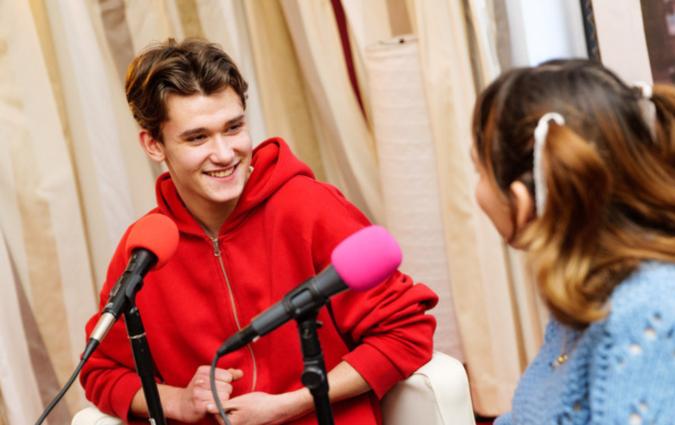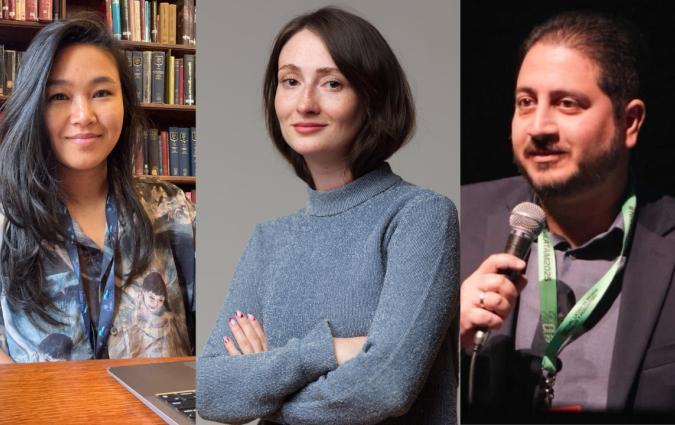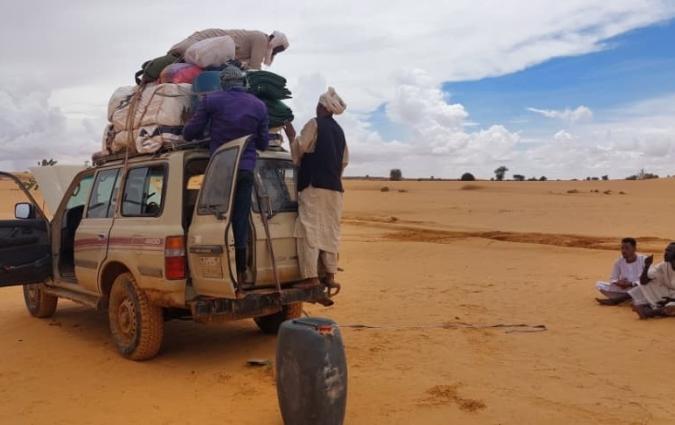Community first: How these news outlets cater to marginalised audiences

A woman applauds as an artistic group performs a "TV news show" on a public transportation bus in Caracas, Venezuela, June 10, 2017. REUTERS/Ivan Alvarado
Mainstream journalism tends to cater to wealthier audiences, who are more attractive to advertisers and more likely to pay for a news subscription. This often excludes underserved communities from mainstream news coverage and creates spaces where poor people’s concerns are hidden from public discourse.
Widespread cuts to donor funding are now raising concerns about sustaining inclusive media projects, many of which have relied on grants to do their work.
“I am really struggling to see all that many examples of [news organisations] succeeding at serving people who are poor, who have low levels of formal education, who are part of minoritised groups, who live far from metropolitan centres,” said the Reuters Institute’s senior research associate Rasmus Kleis Nielsen at the US launch of this year’s Digital News Report.
So where are those outlets? What do they look like? How do they cater to marginalised audiences? What challenges do they face? I spoke to four journalists and experts from around the world to find out.
Why marginalised people tune out
While some large news organisations aim to cater to broader audiences through free offerings, even outlets that by definition should cater to everyone can unintentionally alienate marginalised audiences.
Journalist and researcher Shirish Kulkarni delved into this issue in the News for All project, a collaboration between the Welsh news innovation organisation Media Cymru and BBC Cymru, the Welsh division of the British public broadcaster.
The starting point for the project was to determine ways for public service news providers, such as the BBC, to provide value to everyone. While the BBC reaches 84% of UK adults (those over the age of 16) weekly, according to the BBC Group Annual Report 2024/25, this falls to 67% for 16 to 34-year-olds. Only 51% of this younger age bracket feel ‘the BBC reflects people like them’.
According to our own Digital News Report 2025, 54% of 18 to 34-year-olds access BBC News products weekly in the UK.
News for All aimed to understand why some segments of the population tune out of news by listening to marginalised people in the project, Kulkarni said. Their ‘participatory research’ revolved around discussion sessions led by community members, where there was no strict agenda and the discussions were allowed to flow freely.
The members of the project's focus group agreed they currently saw “journalism as oppression”, with 15 out of 16 participants saying they don’t think journalists represent their community well. The members of the group were news literate and actively made the decision to tune out of traditional news.
“They totally understand the lack of kind of inclusion in newsrooms, and the business model of attacking immigrants, so why would you engage with stuff that is setting out to attack or harm you?” Kulkarni said.
While this is a small sample focused on a community in Wales, Kulkarni believes the lessons from the project are much broader.
Some of the takeaways he shared were to focus on a kind of journalism that provides a route to change, to spend time with and understand the communities being reported on, and to contextualise salient political issues, such as the current focus on immigration to the UK via Channel crossings on small boats, with relevant data and history.
Kulkarni alerts against what he describes as the “dashboardification of journalism” – an overreliance on metrics that tell news organisations about the audience they already have, but not the one they are failing to reach. “Marginalised people need systems to change so that they are not marginalised,” he said.
Telling the right stories
One of the problems identified by Kulkarni’s focus group was the stories themselves, not the format or platform they were delivered through.
“What they’re saying to us is, ‘If that story is attacking or harming me, it doesn’t matter whether it’s on Instagram or Snapchat, I’m still not going to engage with it.’ And what they are saying is, ‘The reason we are not engaging with stuff is because it’s the wrong stories,’” he said.
So outlets that consciously strive to serve marginalised communities are faced with the challenge of identifying the right stories, the issues on which their chosen audience actually wants to be informed.
One of those outlets is Indonesia’s Project Multatuli, a non-profit collective founded by four journalists with a mission statement to ‘serve the underreported’. Project Multatuli describes itself as “a public interest journalism organisation that seeks to empower those who have suffered much,” including the poor and victims of discrimination.
The outlet avoids coverage of big breaking news, such as political stories, and it publishes eight to ten long-form articles each month, including photo stories and occasional essays. Over 70% of their pieces mention people living in poverty or experiencing systemic injustice, said managing editor Ronna Nirmala.
Despite this focus, most of Project Multatuli’s current audience comes from the 30 to 40-year-old urban middle class, she said. Similarly, their journalists mostly come from urban areas, so they’re outsiders to the stories of marginalisation that they want to tell.
Project Multatuli tries to work around this by coordinating with grassroots community organisations before sending a journalist to report from the field. They also consult communities in the writing process. Not in ways that would encroach on their editorial independence, Nirmala said, but to ensure they’re using the right terminology and not projecting their own outsider perspective onto the story.
“Some of our reporting is hard to do because these communities have been hurt by journalists who only want to analyse or victimise their problems. They have that trauma, and we understand that,” Nirmala said.
Over Project Multatuli’s first four years, the 18-strong team has built recognition among some of the communities they strive to cover, and now receives emails from community members willing to share their stories.
Covering America’s motor city
Outlier Media is a local, community-focused newsroom serving the Detroit area in the United States. It started as a text messaging system in 2016, with the understanding that phones are safety nets for many people living in poverty.
“The phone bill is one of those things that many Detroiters will pay for,” said Erin Perry, the outlet’s editor-in-chief.
Outlier Media’s goal, she said, is to fill information gaps for the people of Detroit, and to do so, her team is in constant communication with its audience. One of the ways this communication works is through surveys.
Outlier conducts a large yearly survey with the University of Michigan to assess the ‘basic needs’ of Detroiters. These aren’t strictly media needs, but more general concerns like wanting better police responses to crime or improved access to food.
Perry’s team is constantly issuing much smaller surveys in regular newsletters, which readers respond to with a ‘thumbs up or down’ option, asking questions such as ‘Do you like this content? Do you want to see more coverage of [a particular issue]?’
Another way Outlier stays in touch with its audience is through events, such as a monthly ‘coffee Thursday’, in which the team will sit in a local cafe for an hour or so and buy coffee for anyone who walks in.
“That gives us a starting point to have a conversation with them about what their challenges are, what they do in the city, what they like about the city, and what they wish the city had,” Perry said.
They have also kept the texting service, sending out updates and managing a channel through which community members can ask to be put directly in touch with a reporter.
“Most people have not necessarily met a journalist or talked to a journalist. This allows them to do just that,” Perry said.
Occasionally, Outlier will host an event more focused on fun than on news, like a historical bus tour, a graveyard tour focusing on prominent Detroit women, a basketball game or even a dance party. “We give you everything you need to survive, but we are also providing outlets for you to thrive,” Perry explained.
An outlet in Venezuela
La Vida de Nos, founded by Albor Rodríguez and Hector Torres, aims to ‘tell stories that help to understand the Venezuela of today’, with a particular focus on communities often overlooked by traditional media.
The outlet’s nine full-time members work to publish one story per week every Saturday, including reporting on disappearances, migration, and the deterioration of the media environment in Venezuela to which it belongs.
Raylí Luján, broadcast producer at La Vida de Nos, said she monitors the key issues affecting the outlet’s audience through social media. While her colleagues also consult with communities in person, she is no longer able to. Like so many Venezuelans, she left her country for Spain, where she now lives.
“We try to hear the communities first, and hear what the people are talking about, not only on social media, but also in the streets,” she said.
Partnerships and resource-sharing
The three outlets covered in this piece consult and work alongside the communities they write about. In some cases, they even pursue partnerships that allow them to broaden their audience base.
Project Multatuli collaborates with local journalists and media outlets and publishes their pieces.
La Vida de Nos works to fill information vacuums in Venezuela by working with local media partners to distribute its stories in print in parts of the country without internet access. The outlet also works with El Bus TV, a Venezuelan initiative that brings news directly to audiences by reading out stories on public transport.
La Vida de Nos organises workshops and scholarships for young journalists in underserved communities so they can learn to tell their own stories. One of these initiatives was Contar Fronteras, a project for which La Vida de Nos partnered with two other prominent news organisations, El Bus TV and Runrun.es.
Contar Fronteras (Spanish for ‘telling borders’) recruited 16 aspiring journalists from border regions of Venezuela and trained them to tell what was happening in their own communities.
Millions of Venezuelans have left the country since 2015, for reasons including political repression, economic downturn, and human rights violations, leading to the largest recorded refugee crisis in the Americas.
Venezuela’s border regions are particularly dangerous due to drug trafficking and armed groups that operate there. Nevertheless, the young journalists La Vida de Nos mentors are eager to report.
“They have a lot of motivation to tell the stories in their communities, and they want to be better journalists: that is, not the traditional journalists that we knew from 100 years ago. They want to learn about the different presentations of journalism, whether audio, text or digital text; they want to do something for their communities,” Luján said.
In a similar initiative, Outlier Media runs the Detroit Documenters programme, which pays and trains around 700 community members to attend government meetings, take notes and post live updates on Bluesky.
Editors also hold monthly meetings with their counterparts from eight other local outlets in the city, including similar nonprofit newsrooms like Bridge Detroit, specialised publications like education-focused Chalkbeat Detroit, and even legacy newspaper Detroit Free Press. The network shares resources and coordinates coverage to avoid duplication, something particularly important because none of them are ‘resource-rich’, Perry said. Once every quarter, these media partners invite freelancers to their meeting so they can pitch story ideas.
Outlier and its local newsroom partners also collaborated on a safety-focused newsletter, which ran for a year, to address what they identified as an information gap. Safety consistently comes up as a top issue in Outlier’s audience surveys, Perry said.
How to fund outlets focused on the poor
Securing funding for an outlet like Project Multatuli is challenging, Nirmala said. These are not the kind of stories that make news outlets advertising money, so Project Multatuli has to rely on a small pool of funders who share its mission.
Around 70% of the outlet’s funding comes from media donors, 20% from a membership programme, and the rest from collaborations, including one with the OCCRP.
“We are struggling in terms of financing,” Nirmala said. They can’t be sure they’ll receive a certain sum regularly, so they’re always working on proposals and grant applications. “It's always a work in progress,” she said.
La Vida de Nos is exploring new avenues for funding after being affected by widespread donor cuts earlier this year. They’re looking into Substack and subscriber revenue as possible alternatives, Luján said. The team already runs journalism workshops within Venezuela as an additional revenue stream. Another option would be to expand these internationally, she said.
Outlier Media relies on grant funding, mostly from private foundations like the MacArthur Foundation, Skyline Foundation, Democracy Fund and Ford Foundation. Since the Trump administration’s crackdown on diversity policies, the team has had to be aware of, and in some cases adjust, the wording when describing who they serve, Perry said, but they are better placed than many similar outlets.
The line between journalism and advocacy
Some people view Project Multatuli’s journalists as activists. This comes both from sources expecting help that goes beyond publishing a story and from critics of their work. Nirmala views this as a misconception of her team’s work.
“In Indonesia, when you are so focused on marginalised issues, people will say that you are a social justice warrior. People don’t really recognise that what my colleagues and I do is basically just the right kind of journalism,” she said.
In the US, audiences are split over whether it’s acceptable for journalists to advocate for the communities they cover, according to a recent report by the Pew Research Center. Around half (51%) believe it’s always OK for journalists to advocate for the communities they cover, with a further 34% deeming it sometimes acceptable. Only 14% say this is never acceptable.
Perry said Outlier maintains a distinction between journalism and advocacy. Her team does not publish opinion pieces and strives to be transparent about the ways in which they approach their reporting.
One example of this, she said, was a memo Outlier published when the war in Gaza broke out, outlining how it would cover stories related to this issue. The statement explained coverage would follow local angles, and assured readers that issues like death tolls, context and language would be approached thoughtfully.
“What we do is not advocacy. It’s accountability,” Perry said. “We hold ourselves accountable and we hold others accountable as well.”
The role of mainstream media
The journalists I spoke to in Indonesia, Venezuela and the US work in small, more specialised news outlets with a mission that explicitly emphasises underserved and marginalised audiences. So what do they think is missing from mainstream news sources in their countries?
In Indonesia, Nirmala said, more traditional news outlets tend to sensationalise stories about poverty, presenting them in ways that emphasise emotion or spectacle rather than structural issues.
“Mainstream outlets frequently portray marginalised communities through stereotypes, whether as objects of pity, social burdens or statistics, while neglecting to recognise them with rights and agency,” she said.
Nirmala would like to see more media outlets embrace marginalised communities as the primary storytellers of their own experiences. But to do so, she said, “the media must also remain independent, meaning that they have to be free from political, corporate interests, as well as security threats. This poses a challenge, not only in Indonesia but also globally.”
In the US, Perry sees a shortage of mainstream media coverage of poverty in comparison to the proportion of the population that lives below the poverty line. She also reiterates that people actually experiencing poverty should be central to the coverage.
"There needs to be deeper scrutiny — and more authoritative reporting — on the systems that are failing, as well as recognition of the systems that are working. This isn’t about “both-sides” journalism; it’s about meaningful analysis," she said.
Elsewhere, the main obstacle is freedom of the press. In Venezuela, Luján said, mainstream outlets do make a considerable effort to cover poverty, particularly in towns and cities. But those who do this kind of coverage often face threats. “They begin to receive warnings from anonymous accounts telling them to stop covering the story, or attempts to hack their emails,” she said.
In some cases, reporters have been jailed. Journalist Nakary Mena Ramos and her camera operator husband, Gianni González, for example, were arrested in April after Ramos published a story on rising crime in the city of Caracas
In every email we send you'll find original reporting, evidence-based insights, online seminars and readings curated from 100s of sources - all in 5 minutes.
- Twice a week
- More than 20,000 people receive it
- Unsubscribe any time







